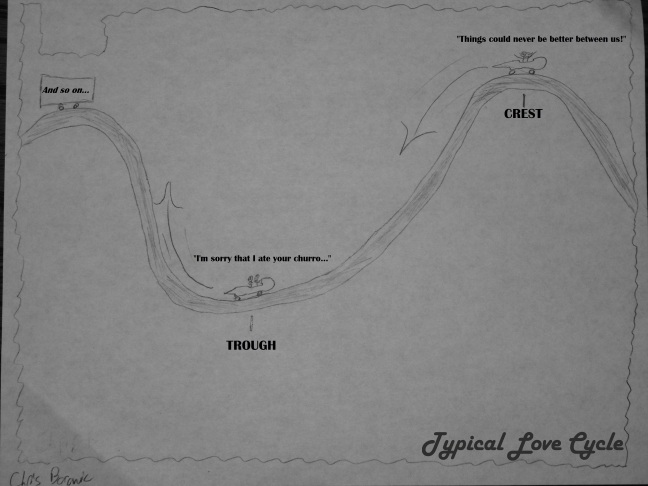Love has preceded the existence of roller coasters for thousands of years. Despite both being constructs of social relationships (Soloski & Pakov773), love and roller coasters are vastly different in physical form. Construction processes, however, are obscurely alike in their own respects. The fundamentals of loving someone and building/riding a roller coaster are similar in that they both need time, create anticipation, and maintain a formed, cyclical pattern during their lifetime.
Save popular belief, roller coasters do not transpire themselves into existence instantaneously when the desire for one arises, and neither do intimate relationships. Building a roller coaster takes an admirable deal of time and vigor, and usually includes the following developmental factors of location, availability of space, roller coaster type, and interference with other facilities (EnginSoft1). Sequentially, the same foundation holds true with developing love for another person: finding a mutual place to meet and converse, making sure the space is private enough to avoid social influence and pressure, whether the relationship will be casual, committed, long distance, etcetera, and deciding if it will cause problems in individual affairs with work, home life, and other activities (though this should not be as prevalent, as maintaining a close, healthy relationship with someone is a difficult rarity compared to most other variables; if it works, follow through with it). The jargon is different, but the processes are the same.
Once a relationship has begun, a conglomerate of questions and emotions surface for internal reflection. Contradictory, anticipatory, and evaluatory emotions such as ecstasy and petrification (“I can’t believe this is happening!”), credence and apprehension (“where the hell are we going?”), even euphoria and melancholy (“sometimes I don’t know what to feel!”), are all common examples. Before a ride begins, and also during a ride, a roller coaster can invoke much of the same feelings in people, though it lacks the ability to muse over it all. This process of inquiry may also be tasked to roller coaster engineers and inspectors. Their objective is to make sure the secure foundation of a roller coaster stays just so, and will not collapse under high forces, natural or unnatural. For roller coaster design, despite its many different styles, must still adhere to regulation so that even if there is a malfunction with any equipment, safety and security will be guaranteed (EnginSoft1). Simply put, the anticipation and evaluation of a roller coaster ensures that it will be on the correct path to “go steady;” the equivalent of loving someone for an extended period of time.
Finally, the foundation and groundwork have been laid, and the coaster has weathered every test. Now, it awaits the ride; a test measured in cycles, years. One would think that things will only look up from this point, but up is just one direction out of a greater variety.
Every roller coaster has its crests and troughs, along with their respective apexes, curves, and swerves; as does every loving relationship, although the troughs don’t exude as much exhilaration compared to riding a roller coaster. For example, a crest in a relationship may resemble moving into a house or an apartment together, the birth of a child, or any considerable positive event. Likewise, a trough would look opposite of a crest; the death of a close relative, doubt in a partner’s conviction, or any considerable negative event. Loving someone does not always come with a pristine package of articulation that contains the proper words or actions. There is no operator directing where one’s limbs should be during the ride to maximize safety (and lawsuits). But a roller coaster ride, despite being wholly enjoyable by most people, can still cause severe cognitive trauma and nausea in others. Every ride and relationship has its own special case of circumstances.

In conclusion, riding a roller coaster and loving someone are Lilliputian in their differences. Although coasters are amusing, they are often short-lived and do not last longer than one minute in most occurrences. Love is found to be more forgiving, rewarding; unpredictable and long-term, fortune and patience permitting. Human interaction trumps almost every activity, and riding a roller coaster is no exception. Coasters have far too many restrictions, including governmental safety rules and regulations, hours of operation, publicity, etcetera (Cavette4), whereas love’s restrictions are infinitesimal in comparison. It is for this reason that love is ultimately superior. Structurally, roller coasters and human beings capable of love are physically dissimilar, and emotionally disparate. However, both the processes of constructing and riding a roller coaster are interchangeable with falling and staying in love. Perhaps riding a roller coaster with someone you love would be a testament to all similarities and differences mentioned.
Works Cited
Cavette, Chris. “Roller Coaster.” How Roller Coaster Is Made. Avameg, n.d. Web. 11 Nov. 2016.http://www.madehow.com/Volume-6/Roller-Coaster.html
Soloski, Kristy, et al. “The Social Construction Of Love Through Intergenerational Processes.” Contemporary Family Therapy: An International Journal 35.4 (2013): 773-792. Academic Search Premier. Web. 11 Nov. 2016.
SpA, EnginSoft. “EnginSoft – Structural: Roller Coasters.” EnginSoft. EnginSoft SpA, n.d. Web. 11 Nov. 2016. http://www.enginsoft.com/technologies/civil-engineering/structural-roller-coasters.html


Really great way of looking at things! I’ve heard people say “Love is like roller coaster,” but this brings a whole new meaning to it. Great.
LikeLike
I have to say your essay was so well written it really pulled me in. I love how you explained everything in such detail and how you really showed us how love was like a roller coaster. Really great read!
LikeLike